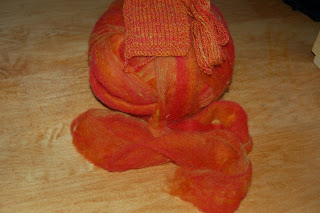

I've had the dye pot going a lot this month, doing lots of immersion dying. So many pretty colors to make roving, batts and yarn with.
If I am mixing different types of fiber that will all be the same color, I weigh and dye them all together. Place the lighter fibers into the pot first. Mohair usually weighs more than most fibers and also takes on color well, so I place that in last. I usually add some wool to my mohair to give some spring and memory. I like other fibers too like alpaca, angora and silk which provide softness. Mohair accepts dye wonderfully resulting in bright, vivid colors
Equipment:
Large Pot: Mine is an extra large water bath canner, the enamel coated variety.
Stirring Tool: I have a large wooden paddle.
Measuring spoons
Canning Jar: for dissolving the dye
Materials:
Clean Fleeces (I wash them except for angora bunny and alpaca)
Dye: I use Pro Chem Washfast Acid fast dyes, which require the following items:
Synthrapol: 1 tsp per pound of fiber (ppf). Used to help the fiber accept the dye
Salt: 1 Tbsp ppf. Must be non iodized, I use pickling salt.
Acid: Vinegar (2/3 cup ppf) or citric acid (1 Tbsp ppf).
Follow the instructions for the dye you are using to get the proper amount to add per pound of fiber (ppf). Experiment some with the amount if you like to see what shades you can get by using more or less dye per pound of fiber.
Weigh the dry fiber. Then soak the fiber in hot water with a 1/2 tsp of synthrapol per pound of fiber for 20 to 30 minutes.
While the fiber is soaking, I start the dye bath. In the large canning pot, I put in enough hot water to fully cover the amount fiber I will be dying. Then I add the proper amounts of synthrapol, salt, and the vinegar or citric acid. My canning jar fits over two of the burners on my stove, so I turn both of them on and heat the water to about 200 degrees.
I like to prepare the dye by pouring boiling water into a canning jar and adding the measured dye powder. Mix this very thoroughly. Add the dissolved dye to the large pot and mix the dye bath thoroughly.
The dye bath is now ready for the fiber. Squeeze water from the soaking fleece and place the fleece into the pot. I start with the lightest fiber first, placing the heaviest fiber in the pot last. Gently mix the fiber for a few minutes. I usually tend to push the fiber down into the pot with the wooden paddle, gently going from one area to another. Just don't agitate the fiber and cause felting. Keep the temperature around 200 degrees (unless you are using silk, then stay under 185 degrees) for approximately an hour. I tend to check the color of the dye bath along the way, if there is a lot of dye left in the water, more vinegar can be added, about 1/2 cup. Simmer for another 15 minutes or so.
Allow the dye bath to cool. Rinse the fiber in warm water.
I like to use my washing machine (must be a top loader) to rinse and spin out the water. Then I spread the fleece out on a screen and dry it, enjoying the splendid colors.













